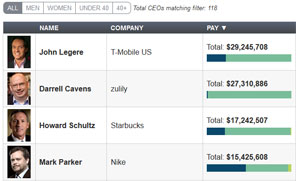Originally published June 21, 2014 at 8:00 AM | Page modified June 22, 2014 at 8:04 AM
The few female CEOs around do hit the pay jackpot
There are too few women in the Equilar study to make anything of that difference in pay or to come to any definitive conclusions about gender and pay at the CEO level.
New York Times News Service

Indra Nooyi: of PepsiCo, earned $13.2 million last year.

Phebe Novakovic: General Dynamics’ head made $18.8 million.
Pulling away: 5 highest-paid local CEOs
Stock benefits separated the highest-paid executives of Northwest public companies from the rest in 2013.
1) John T. Legere, T-Mobile US, $29.2 million total
2) Darrell Cavens, zulily, $27.3 million total
3) Howard Schultz, Starbucks, $17.2 million total
4) Mark Parker, Nike, $15.4 million total
5) Spencer Rascoff, Zillow, $10.6 million total
Source: Equilar and SEC documents
![]()
If you were Marissa Mayer, of Yahoo, making nearly $25 million for one year’s worth of work — not to mention getting $50,000 in company-paid personal security — the gender pay gap would probably not be a major concern. Women scaling the heights of corporate America tend to have compensation packages that are as jaw-droppingly gigantic as those of men at a similar level.
But here’s the thing: They hardly ever get there.
The Equilar Top 200 Highest Paid CEO Rankings, conducted for The New York Times, included just 11 women. That’s 5.5 percent of the total and similar to the 4.9 percent representation of female chief executives at the 1,000 biggest companies.
It raises questions about whether executive compensation is out of hand and whether it is to blame for national economic inequality. But the numbers also reflect another imbalance — the lack of women at the pinnacle of corporate America.
Equilar, an executive-compensation data firm, looked at companies with market values of $1 billion or more that had filed proxies by May 30.
Median pay for the women on the list of 200 CEOs is $15.7 million — $1.6 million less than the median for men and for the group overall. There are too few women in the Equilar study to make anything of that difference in pay or to come to any definitive conclusions about gender and pay at the CEO level. But the findings of a range of economists who have studied chief-executive pay suggest that high-ranking women tend to do as well as high-ranking men — with some important caveats.
Those academic studies, along with the careers of the women on the list, provide a window into understanding why their numbers are so stubbornly low and why it seems to be easier in certain industries — most surprisingly, perhaps, in technology — for women to achieve the same level of success as men in terms of rank and pay.
For a woman whose career goal is to make scads of money, here are the basics: Get a job in tech, start at the highest-level job possible, work your way up to run a piece of the company’s business (meaning, don’t become the general counsel or head of human resources), work for a company with women on its board or among the chief-level executives known as the C-suite — and whatever you do, don’t quit.
The highest-paid woman on the Equilar list was born a man.
Martine Rothblatt, born Martin Rothblatt, was the married father of four children and started Sirius Satellite Radio, now SiriusXM, before undergoing gender-reassignment surgery in 1994. After one of her children was diagnosed with a disease, she founded United Therapeutics in 1996 and helped develop a drug to treat the illness. Last year, she was paid $38 million in compensation, most of it in stock options, putting her at No. 10 on the list. She declined to be interviewed.
“Her equity grant is awarded based on company performance, the best way to be aligned with the interests of shareholders,” said Andrew Fisher, deputy general counsel at the company.
Its stock price more than doubled last year, largely because it received Food and Drug Administration approval for a new drug, Orenitram.
Mayer, at $24.9 million, was the second best-paid woman, followed by Carol Meyrowitz, who made $20.7 million as head of TJX Cos., owner of T.J. Maxx, the discount-apparel store. Both also received the bulk of their pay in stock and options.
Consumer-goods companies have historically had the most female chief executives, and two of the highest-paid women on our list are in that industry — Indra Nooyi, of PepsiCo, who made $13.2 million, and Irene Rosenfeld, of Mondelez International, formerly part of Kraft Foods, who made $14 million. But last year, two women became chief executives in a less traditionally female industry: military contracting. They are Marillyn A. Hewson at Lockheed Martin ($15.7 million) and Phebe Novakovic, of General Dynamics ($18.8 million.)
Studies show women in chief-executive posts are paid less than men. But two of the most comprehensive and respected studies of executive compensation found little evidence of a gap between male and female chief executives after controlling for age and years of experience.
The most troubling sign might be that the increase in the number of women in high-ranking jobs has stalled, according to the 2013 census of the 500 biggest companies by Catalyst, a nonprofit research firm studying women in business. Women hold 16.9 percent of board seats and 14.6 percent of executive posts, and account for 8.1 percent of the top five earners at those companies — all numbers that have stopped growing. The percentage of female chief executives at the 1,000 largest companies is growing, but at a tortoiselike rate — from 1.7 percent a decade ago to 4.9 percent now.
“I wouldn’t call 4 percent representation progress, and certainly not rapid progress,” said Heather Foust-Cummings, leader of the Catalyst Research Center for Equity in Business Leadership.
 Four weeks for 99 cents of unlimited digital access to The Seattle Times. Try it now!
Four weeks for 99 cents of unlimited digital access to The Seattle Times. Try it now!



















